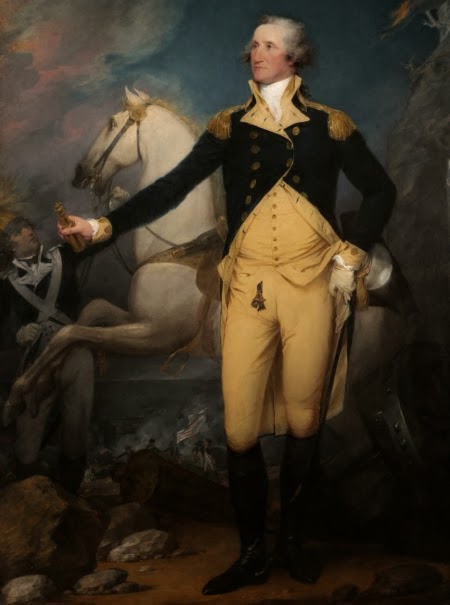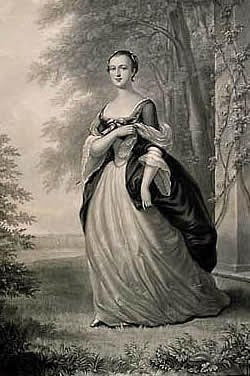 |
| George Washington |
George Washington, a fourth-generation Virginia planter, played a central role in every phase of America’s separation from Britain and creation of the United States. Acclaimed during his own lifetime as Father of his Country, Washington was indeed the American Revolution’s “indispensable man.”
One of seven children of Virginia landholder Augustine Washington, George’s formal education ended when he began training as a surveyor at age 16. Over six feet tall and heir to Mount Vernon, George, a stockholder in Virginia’s Ohio Company, was picked by the Virginia House of Burgesses in 1754 to help command troops sent west to assert the private land company’s claims to territory controlled by the French and their Indian allies.
In what would prove to be opening maneuvers in the Seven Years’/French and Indian War, Washington and his troops killed a French commander and a Seneca chieftain, erecting Fort Necessity to consolidate British/Virginian regional claims. The French soon countered, killing one-third of his men, but Washington and his remaining troops were allowed to evacuate.
  |
Working closely with British generals as war broke out in earnest, Washington would learn important lessons about British ways of warfare. The massacre of General Edward Braddock and two-thirds of his troops at Fort Duquesne in 1755 showed Washington the futility of fighting a European-style war amid harsh frontier terrain. Like many others, he seethed at British arrogance and condescension toward colonial troops.
Elected in 1758 to the House of Burgesses, Washington consolidated his position as a leading Virginian by marrying Martha Dandridge Custis, the colony’s wealthiest widow, becoming stepfather to her son and daughter.
He would spend the years prior to 1775 as both country squire and active farmer, expanding and diversifying his plantations, acquiring more than 300 slaves. A tough taskmaster who pursued runaways, Washington nevertheless tried to keep slave families intact, endorsed the gradual elimination of slavery, and arranged for his own slaves’s emancipation in his will.
Chosen in 1775 to organize and lead a Continental army, Washington made serious errors and struggled to fill and train his ranks. Yet his skill at avoiding or escaping disastrous encounters, combined with bravery, self-discipline, and quiet confidence, enabled Washington to eventually cooperate with state militias and keep his often sick and hungry army together.
 |
| Martha Dandridge Custis |
Washington’s retirement would not last long. His military service had convinced him of the need for a government strong enough to field an effective army. As a member of the landed gentry, he also saw in the 1786 Shays’s Rebellion by poor western Massachusetts farmers and veterans the seeds of collapse of the new nation. Persuaded to chair the Constitutional Convention in Philadelphia in 1787, he brought order and legitimacy to the closed-door proceedings while playing only a minor role in its debates.
Once enough states had ratified the U.S. Constitution, Washington was unanimously chosen as the United States’s first president, taking office in New York City on April 30, 1789. Focusing on fiscal stability and political credibility, Washington selected trusted colleagues, including Alexander Hamilton, his former military aide, and fellow Virginian Thomas Jefferson, former ambassador to France, for what became known as the cabinet. As Americans debated what to call their new leader, Washington discouraged “regal” titles in favor of “Mr. President.” By 1790 Americans were celebrating their president’s February 22 birthday.
Governing did not always prove so rewarding for the aging leader. As Hamilton and Jefferson clashed over a series of vital issues, factions, soon to become political parties, vied for Washington’s backing. His second term was especially difficult. Although Washington’s presidency was avowedly nonpartisan, his opinion of the French Revolution, as it declined into anarchy, revealed him as a Federalist and sparked abuse from the Republican press.
The 1794 Whiskey Rebellion
Washington had a final precedent to set. With Hamilton’s help he crafted a farewell address to announce that he would not seek a third term. In it, Washington urged Americans to come together as a nation and warned against foreign alliances based on other than sound national interests.
Washington’s second voluntary withdrawal from power set an example that only one U.S. president, Franklin D. Roosevelt, has ever breached. In his final retirement, Washington closely monitored construction of the new federal district that would bear his name, renovated Mount Vernon, and added to his vast land holdings.
He died of a throat infection at age 67 after insisting on riding out to do chores in a freezing December rain. An outpouring of tributes ensued, none better remembered than Congressman Henry Lee’s “First in war, first in peace and first in the hearts of his countrymen.”